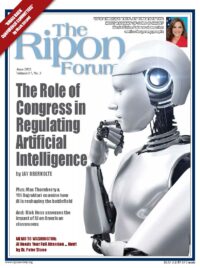
Artificial Intelligence (AI) has emerged as a transformative force in various industries, including transportation. In the United States, AI is revolutionizing the way people travel, commute, and transport goods. This essay explores the profound impact of AI on transportation in the US, discussing its benefits, challenges, and potential future developments.
That paragraph was produced by ChatGPT in only a few seconds as the introduction to an 800-word essay on AI and transportation. The article went on to discuss impacts on efficient traffic management (200 words), enhanced safety measures (200 words), optimized logistics and freight management (200 words), challenges and considerations (150 words), future developments (150 words), and conclusion (100 words).
It was my first foray using ChatGPT (or any other large language model). I hesitated to ask it for my biography, as suggested by a friend. I figured I would need a nourishing drink for that. I had sketched out my own article before asking ChatGPT and that’s what follows. But ChatGPT’s essay would certainly have passed muster as an undergraduate – or even graduate student – essay on the topic.
ChatGPT is right – AI has emerged as a transformative force in transportation. It will affect both how we use transportation – the demand side – and how we supply transportation facilities and services.
AI has emerged as a transformative force in transportation. It will affect both how we use transportation – the demand side – and how we supply transportation facilities and services.
The supply side has some obvious areas where changes could come, although it’s hard to predict how much and how fast. AI can and most likely will advance the boundary of delivery. We already have hundreds of cooler-sized Starship robots delivering food and drinks around my university’s campus. AI can make that faster, better, and cheaper almost certainly. Better drones on land and sea and in the air? Yes. Better driver assistance systems like crash avoidance? Already here with more to come. Autonomous cars and trucks? Related to the drone question, but yes in time.
The demand side is harder to assess. An axiom of the transportation field is that transportation is a “derived demand.” Human travel typically arises from people’s desire to consume something else at a spatial remove – to shop, study, worship, work, socialize, eat at a restaurant, engage in military battle, and so forth. To be sure, some travel is instrumental – jogging, joyriding, or recreational bicycling. Similarly, goods transport arises from the desire of a buyer and seller to exchange goods for compensation.
The impact of AI on transportation is thus inextricably tied to the broader social, economic, and geopolitical environment, which will also be encountering the effects of AI. Consider the commercial real estate sector and the changes wrought by remote working. A commercial office building in downtown San Francisco is on the market and expected to sell at an 80 percent markdown from its pre-Covid price. Eighty percent! That’s not AI, but it provides a hint of how a technology as simple as video conferencing, which was demonstrated at the Bell Telephone display at Expo ’67 in Montreal when I was a kid, has suddenly swept the world.
In the world of goods movement, impacts are likely to be large as well. AI may shift the efficiency frontier between the onshoring and offshoring of manufacturing. If factories using AI can reduce onshore production costs, the demand for shipping goods from remote markets may decline.
One of the ways that AI works is through the creation of “deep fakes,” that is a fake so good that you can’t tell it’s not genuine. The deep fakes often are developed by placing two AIs in competition with each other. One AI produces the fake, and the other AI tries to detect whether it’s genuine. As the fakes get better, the detector gets better, and vice versa.
A 2022 study found that “up to 94 percent of long-haul trucking operator-hours may be impacted as the technology improves to operate in all weather conditions.”
What might that mean for transportation? Counterfeit spare parts is one area of concern. Spare parts that support safe operation of equipment – aircraft, ships, automobiles – have potentially deadly effects if they aren’t genuine. Counterfeit credentials are another concern.
Still another concern is the impact of artificial intelligence on job growth and employment. A 2022 study by researchers from Carnegie Mellon University and the University of Michigan found that “up to 94 percent of long-haul trucking operator-hours may be impacted as the technology improves to operate in all weather conditions.”
To what extent can we anticipate these impacts? And to what extent must we sharpen our agility to respond quickly, seize opportunities, tackle threats? Incumbent market actors will not take this lying down. Governments at all levels can expect requests from all types of incumbents to protect their businesses. That could include lawyers, engineers, container shipping crane operators, truck drivers, and other service workers who might be facing displacement.
But we should keep in mind that AI has the potential to help society tackle some of the big challenges we face in the decades to come. Feeding, clothing, housing, and educating a growing global population poses enormous challenges. Faster, better, cheaper, and more environmentally beneficial transportation can help tackle those challenges. AI can play an important part in helping us to achieve those objectives.
Meanwhile, it may be time for me to fix a drink and ask ChatGPT for my biography
Jonathan L. Gifford is a professor in the Schar School of Policy and Government at George Mason University, and the director of the Center for Transportation Public-Private Partnership Policy.




